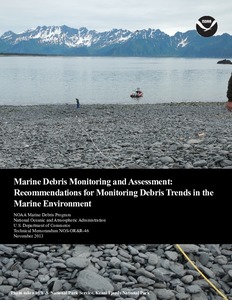| dc.identifier.citation | Lippiatt, S.; Opfer, S. and Arthur, C. (201). Marine Debris Monitoring and Assessment: Recommendations for Monitoring Debris
Trends in the Marine Environment. Silver Spring, MD, NOAA Marine Debris Division, 82pp. (NOAA Technical Memorandum NOS-OR&R-46). DOI: http://dx.doi.org/10.25607/OBP-727 | en_US |
| dc.description.abstract | Marine debris is defined by the National Oceanic and Atmospheric Administration (NOAA) and
the United States Coast Guard (USCG) as any persistent solid material that is manufactured or
processed and directly or indirectly, intentionally or unintentionally, disposed of or abandoned
into the marine environment or the Great Lakes (33 USC 1951 et seq. as amended by Title VI of
Public Law 112-213). Marine debris has become one of the most recognized pollution problems
in the world’s oceans and waterways today.
In recent years, research efforts have significantly increased knowledge of the topic of marine
debris. However, the field as a whole has not adopted standardized monitoring procedures or
debris item categories. Standard methodology and reporting is necessary in order to compare
marine debris source, abundance, distribution, movement, and impact data on regional, national,
and global scales.
The NOAA Marine Debris Program (MDP) has developed standardized, statistically valid
methodologies for conducting rapid assessments of the debris material type and quantity present
in a monitored location. The monitoring guidelines in this document focus on abundance, types,
and concentration rather than analyzing by potential source, as in many cases it is very difficult
to connect a debris item to a specific debris-generating activity. These techniques are intended to
be widely applicable to enable comparisons across regional and global scales.
This document includes guidelines for estimating debris concentrations on shorelines, in surface
waters, during visual surveys at sea, and in the benthos. Background information is provided for
each environmental compartment (i.e., shorelines, surface waters, and the seafloor), in addition
to guidelines for survey design, required equipment, the survey techniques, and study
implementation considerations. The appendices include a brief literature review for each
compartment, survey data sheets, a debris item photo guide, frequently asked questions for
shoreline surveys, and a summary of work completed by Versar, Inc. to test the methodologies.
The techniques described in this document were developed over the course of a number of years,
based on a review of the literature, discussions with experts, and field testing by the MDP and
contractors. For shoreline monitoring, the MDP benefited from feedback from partner
organizations who implemented these methods prior to the official publication of these
guidelines.
The guidelines in this document are intended for use by managers, researchers, citizen scientists,
and other groups conducting marine debris survey and assessment activities, especially those
requiring a rapid assessment. Monitoring and assessment of marine debris is essential to
understanding the problem and being able to mitigate, prioritize, and prevent the most severe
impacts. The effort to develop this document was rooted in the need to standardize
methodologies and facilitate comparisons across time, space, and environmental compartments.
These guidelines are provided to the marine debris community at large in order to guide the
development of integrated monitoring programs nationwide. | en_US |
 Repository of community practices in Ocean Research, Applications and Data/Information Management
Repository of community practices in Ocean Research, Applications and Data/Information Management

